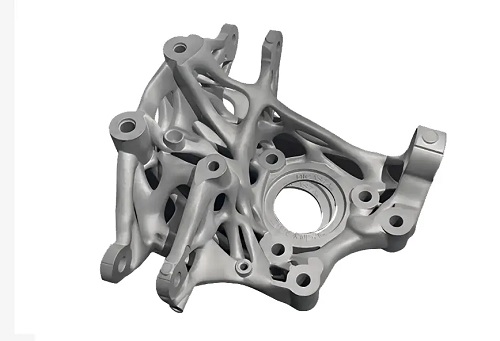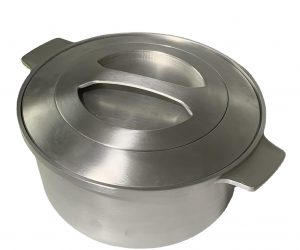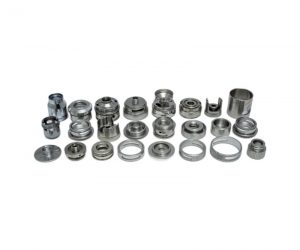Electron Beam Melting (EBM) Impressão 3D: A Deep Dive into Manufatura aditiva's Apex Predator
I. Introduction: Beyond the Hype – EBM's Disruptive Potential
A. EBM: Redefining the Limits of Precision Metal Fabrication
Additive manufacturing, once a niche technology, has exploded onto the global stage. Within this dynamic field, Electron Beam Melting (EBM) stands apart, not as a mere incremental improvement, but as a paradigm shift. EBM leverages the focused power of a high-energy electron beam to selectively fuse metallic powders, layer upon meticulously layered layer, within a high-vacuum chamber. This process transcends the limitations of subtractive manufacturing, enabling the creation of intricate geometries and complex internal structures previously relegated to the realm of theoretical design. The result? High-performance metal components boasting superior mechanical properties, unmatched precision, and a density that rivals traditionally forged parts.
B. A Technological Cambrian Explosion: EBM's Transformative Impact
The implications of EBM extend far beyond incremental efficiency gains. This technology is catalyzing a fundamental restructuring of manufacturing processes across diverse sectors. From the aerospace industry, where weight reduction is paramount, to the biomedical field, demanding biocompatible materials with intricate designs, EBM is not just improving existing processes; it's fundamentally redefining what's possible. Its influence is a ripple effect, impacting supply chains, design philosophies, and the very definition of "manufacturable." The future of manufacturing, in many respects, is being forged, quite literally, in the high-vacuum crucible of the EBM machine.
II. Unveiling the Mechanics: Delving into the EBM Process
A. The Electron Beam's Dance: Precision Fusion at the Nanoscale
The core of EBM lies in the precise control of a high-energy electron beam. Unlike laser-based techniques susceptible to thermal gradients and surface irregularities, the electron beam's interaction with the metal powder is characterized by a highly localized energy deposition. This results in a more homogenous melt pool, minimizing porosity and ensuring exceptional dimensional accuracy. The vacuum environment further mitigates oxidation and other atmospheric contaminants, preserving the integrity of the material and enhancing the final product's mechanical properties. The process is a delicate ballet of energy, vacuum, and material science, resulting in a level of precision that pushes the boundaries of additive manufacturing.
B. Material Alchemy: Exploring the EBM Material Spectrum
EBM's versatility extends to its material compatibility. While titanium alloys (Ti6Al4V, Ti6Al7Nb) remain a cornerstone, the technology's reach encompasses a wide range of metals and alloys, including cobalt-chromium (CoCr), inconel (e.g., Inconel 718), and various stainless steel grades. The selection of material is dictated not only by the application's demands (strength, corrosion resistance, biocompatibility) but also by the powder's characteristics – particle size distribution, flowability, and chemical composition – all of which influence the final part's microstructure and mechanical performance. The ongoing research into novel materials and powder formulations promises to further expand EBM's capabilities.
C. A Comparative Analysis: EBM's Competitive Edge
EBM's advantages over competing additive manufacturing technologies are multifaceted. While other methods, such as Selective Laser Melting (SLM), offer speed advantages, EBM distinguishes itself through its superior density, reduced porosity, and exceptional surface finish. This translates to enhanced mechanical properties, crucial in high-stress applications. Furthermore, EBM's ability to produce larger parts and its inherent capacity for complex internal structures provide a significant competitive edge, solidifying its position as a leading technology in high-value manufacturing. The trade-offs – primarily build speed – are often easily outweighed by the superior quality and performance characteristics of EBM-produced components.
III. Electron Beam Melting (EBM): A Deep Dive into Workflow and Technological Nuances
A. Model Genesis and Pre-Production Optimization: Navigating the Labyrinth of EBM Design
The efficacy of EBM 3D printing hinges critically on the meticulous design and preparation of digital models. This transcends mere CAD proficiency; it demands a profound understanding of EBM's inherent constraints and capabilities. Engineers must not only leverage advanced CAD software and specialized EBM-compatible file formats (e.g., STL, but often requiring proprietary pre-processing) but also master the art of part orientation for optimal support structure generation – a crucial step often overlooked, leading to catastrophic build failures. Furthermore, the selection of build parameters, a complex interplay of energy density, scan speed, and layer thickness, directly impacts the final microstructure and, consequently, the mechanical properties of the printed component. This pre-production phase is not merely preparatory; it is the architect of the final product's success or failure. Ignoring the subtleties here can lead to unforeseen and costly consequences.
B. The EBM Process: A Choreographed Dance of High-Energy Precision
The EBM process itself is a tightly controlled, high-vacuum environment where a finely focused electron beam, accelerated to kilovolts, meticulously traces the contours of each digitally defined layer. This process is far from simple melting; it involves complex interactions between the electron beam, the metal powder bed, and the nascent component. The precise control of beam parameters, coupled with real-time monitoring systems (often employing advanced image processing and machine learning algorithms), ensures layer-by-layer fusion with exceptional consistency. Deviations from ideal parameters, even minute ones, can propagate through the build, resulting in defects ranging from subtle porosity to catastrophic part failure. The iterative nature of the process, with the build platform incrementally descending, demands sophisticated control systems capable of handling thermal gradients and maintaining dimensional accuracy across potentially large build volumes.
C. Post-Processing: Refining the Raw Potential of EBM-Fabricated Components
The EBM process culminates not in a finished part, but rather in a precursor requiring significant post-processing. This involves not merely the removal of support structures (often a complex and delicate operation requiring specialized tooling and expertise), but also surface finishing techniques (e.g., machining, chemical etching, shot peening) to achieve desired surface roughness and aesthetics. Furthermore, heat treatments, often crucial for stress relief and microstructure optimization, are frequently employed. Rigorous quality control, encompassing dimensional metrology, non-destructive testing (NDT) such as X-ray inspection, and mechanical testing, is essential to verify the component's conformity to specifications and to ensure its fitness for purpose. The post-processing stage represents a significant investment, both in terms of time and resources, but it is absolutely critical for delivering parts that meet stringent industrial standards.
IV. Industrial Applications: EBM's Expanding Reach Across Diverse Sectors
A. Aerospace and Defense: Forging the Future of Flight and Security
The aerospace and defense sectors have embraced EBM's unique capabilities, leveraging its capacity to fabricate complex, lightweight, and high-strength components for demanding applications. This extends beyond simple geometries; EBM enables the creation of intricate lattice structures, optimizing strength-to-weight ratios crucial for aerospace applications. The ability to produce near-net-shape parts minimizes material waste and simplifies assembly, reducing production costs and lead times. Furthermore, EBM's capability to utilize high-performance alloys (e.g., titanium aluminides, nickel superalloys) further enhances the performance envelope of critical components.
B. Biomedical Engineering: Revolutionizing Personalized Healthcare
EBM's precision and biocompatibility make it ideally suited for the production of customized medical implants and devices. The ability to create intricate, patient-specific designs, coupled with the use of biocompatible materials (e.g., titanium, cobalt-chromium alloys), is revolutionizing fields such as orthopedics and maxillofacial surgery. The potential for personalized medicine, enabled by EBM's additive manufacturing capabilities, offers unprecedented opportunities for improved patient outcomes and enhanced quality of life.
C. Tooling and Die Manufacturing: Redefining Precision and Efficiency
EBM's impact extends to tooling and die manufacturing, where its ability to create complex, high-precision molds and dies offers significant advantages over traditional subtractive methods. The production of conformal cooling channels within molds, for example, enhances cooling efficiency and reduces cycle times. Furthermore, the ability to fabricate tools from high-temperature, wear-resistant materials significantly extends their service life. This translates to enhanced product quality, reduced production costs, and increased overall efficiency.
V. Advantages of EBM: A Synthesis of Precision, Efficiency, and Performance
A. Unmatched Accuracy and Geometric Complexity: Beyond the Limits of Traditional Manufacturing
EBM's core strength lies in its ability to produce parts with exceptional accuracy and intricate geometries. The precision of the electron beam, coupled with the controlled environment, allows for the creation of components with features far exceeding the capabilities of traditional subtractive manufacturing methods. This transcends simple geometric complexity; it extends to the creation of internal channels, lattice structures, and other features impossible to achieve through conventional techniques.
B. Accelerated Production and Cost Optimization: Streamlining the Manufacturing Process
EBM significantly reduces lead times and production costs by eliminating the need for extensive tooling and machining. The additive nature of the process minimizes material waste, and the ability to produce customized parts on-demand reduces inventory costs and streamlines supply chains. This translates to faster turnaround times and improved overall cost-effectiveness.
C. Superior Material Properties: Achieving Unprecedented Durability and Performance
EBM-produced parts exhibit superior material properties compared to those fabricated through traditional methods. The high-energy electron beam promotes the formation of a dense microstructure with minimal porosity, resulting in enhanced mechanical properties such as increased tensile strength, fatigue resistance, and improved thermal conductivity. This makes EBM-printed components ideal for applications requiring exceptional durability and performance under demanding conditions.
VI. Navigating the Labyrinth of Electron Beam Melting: Challenges and Unforeseen Conundrums
A. The Technological Chasm: Capital Expenditure and the Limits of Current Capabilities
The allure of Electron Beam Melting (EBM) 3D printing, with its promise of intricate metal structures, is undeniable. However, the path to realizing this potential is fraught with significant hurdles. The prohibitive cost of EBM systems, encompassing sophisticated hardware and demanding software, creates a substantial barrier to entry, particularly for SMEs. This financial chasm is further widened by the ongoing limitations in build volume, a restricted palette of compatible materials, and the inherent complexities of maintaining equipment reliability – challenges that demand continuous research and development investment, often exceeding the resources of smaller players. The unpredictable nature of material behavior under extreme EBM conditions further complicates the process, necessitating rigorous experimentation and iterative refinement.
B. The Human Element: Skill Acquisition and the Imperative of Workforce Development
The successful deployment of EBM technology transcends mere capital investment; it demands a highly specialized workforce. The intricate interplay between part design optimization for EBM's unique constraints, the nuanced operation of sophisticated equipment, and the critical post-processing procedures necessitates a profound understanding of materials science, engineering principles, and advanced manufacturing techniques. The scarcity of individuals possessing this multifaceted expertise underscores the urgent need for robust training programs and strategic workforce development initiatives. Failure to cultivate and retain this specialized talent pool risks undermining the transformative potential of EBM.
C. Ensuring Fidelity: Quality Control, Standardization, and the Pursuit of Certainty
The burgeoning adoption of EBM across diverse sectors necessitates a paradigm shift in quality control and standardization. The creation of high-quality, reliable components requires the implementation of rigorous, multifaceted testing protocols, incorporating advanced in-situ monitoring systems capable of real-time process parameter analysis and predictive modeling. The absence of universally accepted industry standards and certifications introduces uncertainty and hinders the widespread acceptance of EBM-produced parts, particularly in regulated industries. Overcoming this requires collaborative efforts between researchers, manufacturers, and regulatory bodies to establish robust, verifiable quality assurance frameworks.
VII. EBM's Evolving Landscape: Emerging Trends and the Uncharted Future
A. Technological Leaps and Material Frontiers: Anticipating the Next Generation of EBM
The field of EBM 3D printing is poised for a period of rapid and potentially disruptive innovation. Ongoing research promises breakthroughs in areas such as significantly increased build volumes, the development of radically enhanced scanning strategies that minimize residual stress and improve surface finish, and the creation of novel high-performance metal alloys with tailored properties. These advancements will not only enhance the efficiency and capabilities of existing EBM systems but also unlock entirely new applications, potentially revolutionizing sectors currently beyond the reach of this technology. The unpredictable nature of materials science, however, suggests the possibility of unforeseen challenges and opportunities.
B. Reshaping Manufacturing and Design: A Paradigm Shift in Industrial Processes
The impact of EBM extends far beyond the technical realm. Its widespread adoption has the potential to fundamentally redefine manufacturing and design paradigms. By liberating engineers and designers from the constraints of traditional subtractive manufacturing, EBM empowers the creation of complex geometries and functionally graded materials, leading to innovative designs previously deemed impossible. This fosters collaborative workflows, accelerates product development cycles, and unlocks the potential for game-changing products that push the boundaries of performance and functionality. The unpredictable consequences of such widespread adoption, however, require careful consideration of its societal and economic implications.
C. Sustainability and the Environmental Footprint: Balancing Technological Advancement with Ecological Responsibility
In an era of heightened environmental consciousness, the sustainability of manufacturing processes is paramount. EBM, with its inherent material efficiency and reduced waste generation compared to traditional methods, presents a compelling case for a more eco-friendly approach. The potential to utilize recycled metal powders further enhances its environmental credentials. However, the energy consumption associated with the EBM process and the potential environmental impact of the materials themselves require careful scrutiny. A holistic life-cycle assessment, encompassing energy usage, material sourcing, and waste management, is crucial to fully evaluate EBM's true environmental impact and ensure its alignment with broader sustainability goals. The unpredictable long-term consequences of widespread adoption demand ongoing monitoring and adaptation.
VIII. Case Studies: Deconstructing the EBM 3D Printing Paradigm Shift
A. Beyond the Hype: Disruptive Innovation in Action
The transformative potential of Electron Beam Melting (EBM) 3D printing transcends theoretical musings; its impact is etched into the very fabric of industry leaders. We are not merely observing incremental improvements, but a fundamental restructuring of manufacturing paradigms. Aerospace behemoths, for instance, are not simply utilizing EBM for lightweight engine components; they are leveraging its unique capabilities to engineer previously impossible geometries, pushing the boundaries of aerodynamic efficiency and structural integrity. Similarly, the medical device sector is not merely customizing implants; it is generating biocompatible structures with intricate internal architectures, paving the way for personalized medicine and revolutionary surgical interventions. These case studies, however, reveal more than mere successes; they expose the intricate interplay of technological hurdles overcome, innovative solutions implemented, and the often unforeseen consequences that redefine project success itself. Analyzing these narratives allows us to predict, with a higher degree of accuracy, the trajectory of EBM's disruptive influence across diverse sectors.
B. Material Science's Symbiotic Dance with EBM: Unforeseen Synergies
The progress of EBM is inextricably linked to advancements in material science. This is not a unidirectional relationship; rather, it's a dynamic interplay where the limitations of one field spur innovation in the other. Collaborative research, far from being a linear process, is a chaotic, iterative dance, producing unexpected breakthroughs in metal alloy development. The resulting materials exhibit properties previously deemed unattainable, challenging the very definition of material performance. This synergistic evolution extends beyond material properties, impacting the EBM process itself, leading to optimized parameters, reduced defect rates, and the unlocking of entirely new application domains. The consequence is not merely incremental improvement; it's a cascade of disruptive innovations, each feeding the next, accelerating the pace of technological advancement in an unpredictable yet profoundly impactful manner.
C. The Economic and Technological Ripple Effect: A Systemic Transformation
The impact of EBM transcends individual industries; it reverberates across the entire economic and technological landscape. The efficiency gains are not merely cost reductions; they represent a fundamental shift in resource allocation, freeing up capital for further innovation and expansion. This, in turn, fuels a virtuous cycle of technological advancement, creating a competitive advantage that extends beyond individual companies to entire national economies. The ability of EBM to address previously intractable manufacturing challenges positions it as a catalyst for broader technological leaps, fostering innovation not only in aerospace and medical devices but also in sectors as diverse as energy production and advanced tooling. This systemic transformation is not predictable; it's a complex, emergent phenomenon with far-reaching and potentially unforeseen consequences.
IX. Conclusion: Navigating the Uncharted Territories of EBM's Future
A. Redefining Precision: The EBM Legacy
The impact of EBM on manufacturing is not simply transformative; it's epochal. It has not merely refined existing processes; it has redefined the very concept of precision craftsmanship. The creation of complex, high-performance parts is no longer a matter of incremental improvement but a testament to the power of additive manufacturing to reshape the possibilities of design and engineering. The streamlining of workflows is not merely an efficiency gain; it’s a fundamental shift in the organization and management of production. The enhancement of material properties is not simply an improvement in performance; it's a redefinition of material limitations. EBM is not just a game-changer; it is a paradigm shift, leaving an indelible and unpredictable mark on the future of manufacturing.
B. The Unfolding Narrative of EBM: A Future of Limitless Potential
The future of EBM is not a predetermined path; it’s an unfolding narrative, constantly shaped by ongoing advancements in equipment, materials, and process optimization. Its role will become increasingly indispensable, not as a niche technology, but as a fundamental tool in the manufacturing arsenal of forward-thinking enterprises. The design freedom it affords, the production efficiencies it unlocks, and the material innovations it catalyzes will solidify the position of those who embrace it as undisputed leaders in their respective fields. The future of precision craftsmanship is not merely in the hands of those who harness its power; it is defined by their ability to adapt and innovate within the unpredictable landscape that EBM continues to create. The rewards are not merely limitless; they are fundamentally reshaping the very definition of what is possible.
Frequently Asked Questions
2. How does the EBM 3D printing process work, and what makes it unique compared to other 3D printing technologies?
The Electron Beam Melting 3D printing process is unique in its use of a high-energy electron beam to selectively melt and fuse metal powders layer by layer. Unlike other 3D printing techniques that rely on lasers or thermal energy sources, EBM leverages the precise focus and controlled intensity of an electron beam to create parts with exceptional accuracy and consistency. This process takes place in a tightly controlled, vacuum-sealed environment, which ensures optimal conditions for the efficient and consistent melting of the metal powders. The use of an electron beam, rather than a laser, allows for faster scanning speeds and deeper penetration into the metal powders, resulting in parts with superior density and reduced porosity.
3. What are some of the key industrial applications where EBM 3D printing is making a significant impact?
Electron Beam Melting 3D printing has had a transformative impact across various industries, including:
Aerospace and Defense: EBM is used to produce lightweight, high-performance engine components, satellite structures, and specialized military equipment.
Medical Devices: EBM enables the production of customized, biocompatible implants and surgical instruments, revolutionizing patient-centric care.
Tooling and Die Making: EBM allows for the creation of complex, high-precision molds and dies, enhancing product quality and optimizing production workflows.
The ability of EBM to create parts with unparalleled accuracy, durability, and material properties makes it a game-changer in these industries, driving innovation, efficiency, and cost savings.
4. What are some of the key challenges and considerations that manufacturers need to address when adopting EBM 3D printing technology?
Some of the key challenges and considerations in adopting Electron Beam Melting 3D printing include:
High equipment costs and technological barriers: The sophisticated hardware and advanced software required for EBM systems represent a significant investment, which can be a barrier for some manufacturers.
Specialized skillset and training needs: Effective utilization of EBM 3D printing requires a highly skilled workforce, necessitating comprehensive training and talent development.
Quality control and standardization efforts: Ensuring consistent production of high-quality parts requires robust quality control measures, advanced monitoring systems, and the development of industry-wide standards and certifications.
Addressing these challenges through strategic investments, workforce development, and collaborative efforts will be crucial for the widespread adoption and successful implementation of EBM technology in manufacturing.
5. What are the emerging trends and future developments in the world of Electron Beam Melting 3D printing?
The future of Electron Beam Melting (EBM) in 3D printing is set to bring even more amazing improvements. Here’s what we can expect:
- New Tech and Materials: Scientists and manufacturers are working hard to create bigger build sizes, better scanning methods, and new strong metal alloys. This will make EBM machines even more capable.
- Changing Manufacturing and Design: As EBM gets more popular, it could totally change how we think about manufacturing and design. It will allow for new levels of innovation, customization, and craftsmanship.
- Greener Choices: EBM uses materials more efficiently and produces less waste. Plus, it can use recycled metal powders, making it a better choice for the environment compared to traditional manufacturing.
These trends and developments in EBM 3D printing will keep shaking up different industries, pushing them towards more competition, better environmental practices, and the highest standards of manufacturing excellence.




